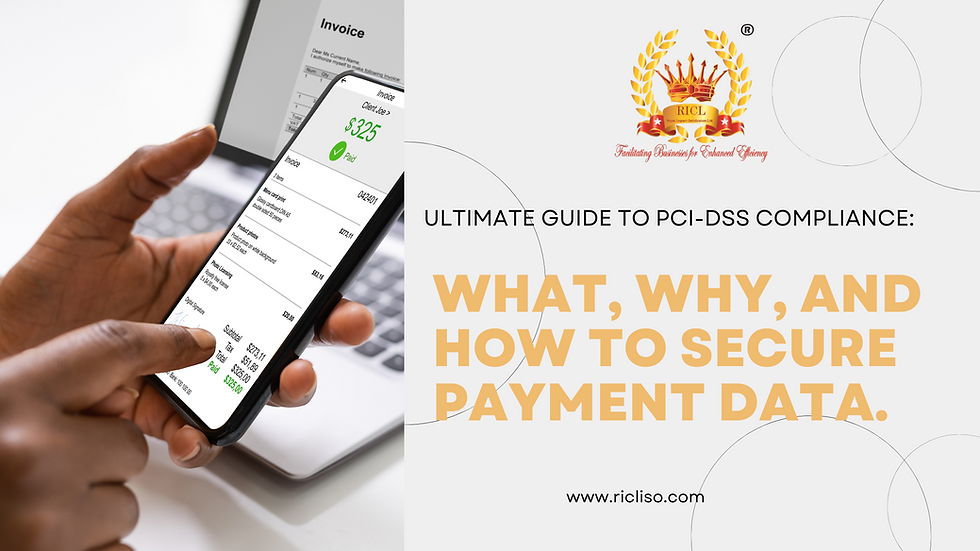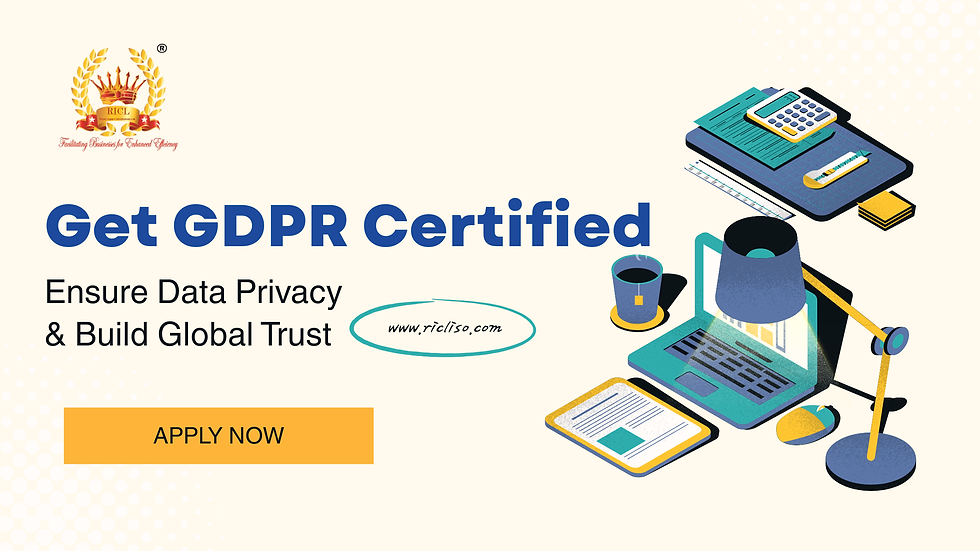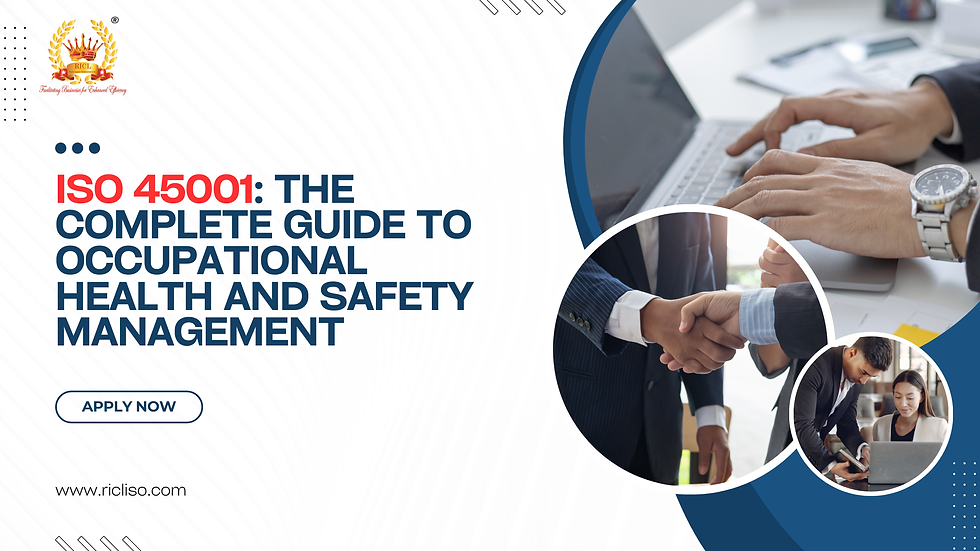Ultimate Guide to PCI-DSS Compliance: What, Why, and How to Secure Payment Data.
- teamitricl
- Jul 29
- 3 min read

Introduction
If your business handles credit or debit card payments, PCI-DSS compliance isn’t optional—it’s essential. But what exactly is it, and why is everyone talking about it?
Let’s break it down.
Understanding the PCI-DSS Framework
The Origin and Purpose of PCI-DSS
The Payment Card Industry Data Security Standard (PCI-DSS) was created in 2004 by major credit card companies (Visa, MasterCard, American Express, Discover, and JCB). Their goal? To combat the rising tide of data breaches and fraud in a rapidly digitalizing world.
Key Organizations Behind PCI-DSS
PCI-DSS is maintained by the PCI Security Standards Council (PCI SSC). While they don’t enforce it directly, the credit card brands do—through their relationships with banks and merchants.
Who Needs to Comply?
Any organization—no matter the size—that stores, processes, or transmits cardholder data must comply. This includes:
E-commerce platforms
Payment processors
Retailers
Hospitality businesses
SaaS companies handling payments
PCI-DSS Requirements Overview
There are 12 core requirements under PCI-DSS, grouped into 6 control objectives:
1. Install and Maintain a Firewall Configuration
Firewalls are your first line of defense against external threats.
2. Do Not Use Vendor-Supplied Defaults
Default passwords and settings are hacker magnets. Change them.
3. Protect Stored Cardholder Data
If you don’t need it, don’t store it. If you must, encrypt it.
4. Encrypt Transmission of Cardholder Data
Cardholder data should never travel the internet unprotected.
5. Use and Regularly Update Antivirus Software
Viruses and malware can easily compromise cardholder data.
6. Maintain Secure Systems and Applications
Always patch known vulnerabilities. Keep software updated.
7. Restrict Access to Cardholder Data
Only those who need the data should have access.
8. Assign Unique IDs to Users
No shared logins. Individual accountability is key.
9. Restrict Physical Access to Cardholder Data
Think locked server rooms, surveillance, and visitor logs.
10. Track and Monitor All Access
Logs help detect and respond to threats early.
11. Regularly Test Security Systems
Penetration testing and vulnerability scanning are musts.
12. Maintain a Policy That Addresses Security
Everyone in the organization should understand their role in security.
Levels of PCI-DSS Compliance
Your compliance level depends on the number of transactions you handle annually.a
Level | Transactions/Year | Validation |
1 | >6 million | On-site QSA audit |
2 | 1–6 million | SAQ + AOC |
3 | 20,000 – 1 million | SAQ |
4 | <20,000 | SAQ (recommended) |
Steps to Achieve PCI-DSS Compliance
1. Determine Your Compliance Level
Your level dictates your validation requirements.
2. Assess Your Current Security Posture
Use PCI-DSS checklists or consult a QSA to identify weaknesses.
3. Fill the Gaps
Implement missing controls or strengthen existing ones.
4. Complete the SAQ or ROC
Based on your level, either self-assess or get a Report on Compliance.
5. Submit the AOC
The Attestation of Compliance goes to your acquiring bank or payment processor.
Common PCI-DSS Compliance Challenges
Defining Scope: Not knowing what systems are in scope leads to gaps.
Legacy Systems: Old infrastructure often doesn’t support modern controls.
Lack of Logging: Many companies forget about requirement 10.
Benefits of PCI-DSS Compliance
Stronger Security = fewer breaches
Customer Trust = repeat business
Avoid Penalties = save money and reputation
It’s not just about checking boxes; it’s about protecting your business.
Non-Compliance Risks
Failing to comply can lead to:
Fines up to $100,000/month
Loss of card processing privileges
Reputational damage
Yikes!
Best Practices for Maintaining Compliance
Train Employees: Human error is the #1 cause of breaches.
Schedule Regular Audits: Don’t wait for something to go wrong.
Update Everything: Systems, policies, and documentation.
PCI-DSS and Other Regulations
HIPAA, GDPR, and PCI-DSS
While PCI-DSS focuses on payment data, HIPAA secures health info and GDPR protects personal data. Some controls overlap, especially around access control and encryption.
Choosing a Qualified Security Assessor (QSA)
QSAs are certified professionals who perform PCI assessments. Choose one with:
Experience in your industry
Transparent pricing
Proven track record
Tools and Technologies for PCI-DSS Compliance
Firewalls & IDS
Tokenization
Point-to-Point Encryption (P2PE)
SIEM Systems
Vulnerability Scanners
Automate where possible to stay ahead.
Future of PCI-DSS
PCI-DSS v4.0 is here with a stronger focus on:
Flexibility in implementation
Continuous monitoring
Risk-based approach
Stay updated—the bad guys do.
Conclusion
PCI-DSS compliance isn’t just a regulatory hurdle—it’s a smart business move. It protects your data, your customers, and your reputation. Whether you're a small online store or a large enterprise, aligning with PCI-DSS means showing the world you take security seriously.
Start small, get help where needed, and stay consistent. Your future self (and your customers) will thank you.
FAQs
1. Is PCI-DSS compliance mandatory?
Yes, for any business that stores, processes, or transmits cardholder data.
2. How often do I need to validate PCI-DSS compliance?
Typically once a year, but monitoring should be ongoing.
3. Can small businesses be exempt?
Nope. Even one transaction requires compliance.
4. What happens if I'm not compliant?
Expect hefty fines, potential legal issues, and a damaged reputation.
5. Is PCI-DSS a one-time process?
No—it’s a continuous effort that evolves with your business and threats.






Comments